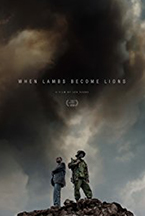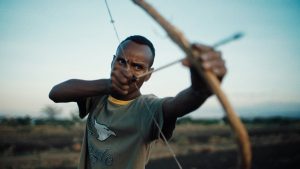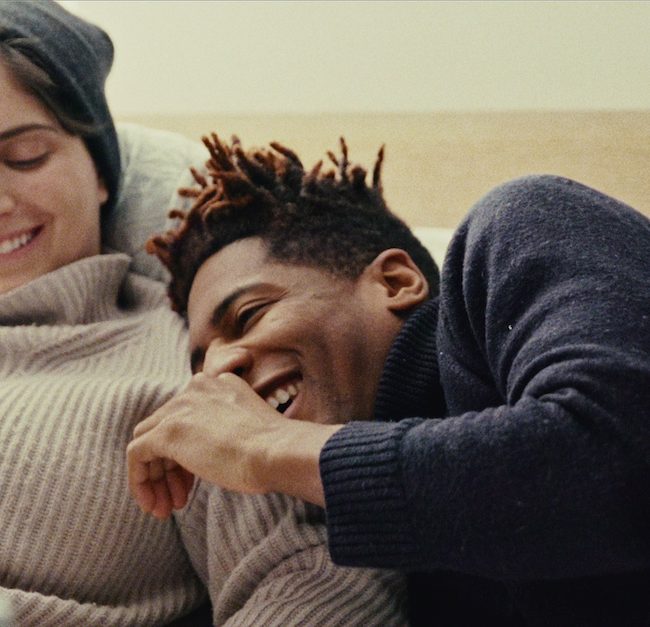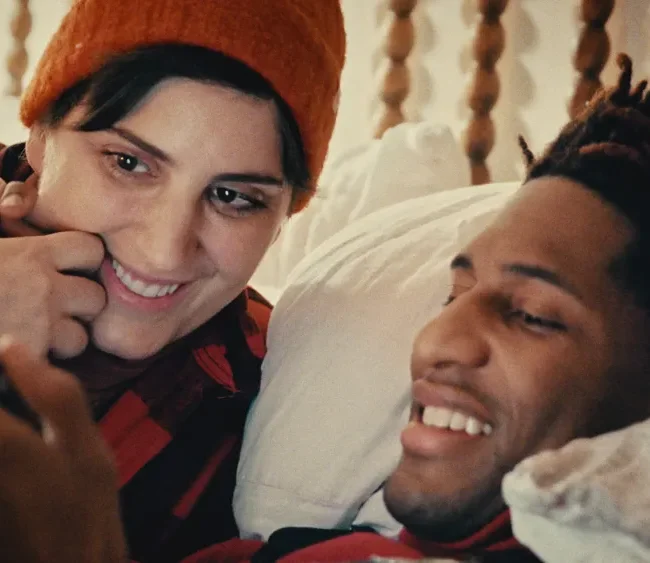A Conversation with Jon Kasbe (WHEN LAMBS BECOME LIONS)
 I met with director Jon Kasbe on Saturday, April 21, at the 2018 Tribeca Film Festival, to discuss his debut feature documentary When Lambs Become Lions (which I also reviewed, and which won the festival’s Best Editing in a Documentary Film Jury Award). The film follows one poacher (“X”) and one park ranger (Asan), cousins to each other, in Kenya, the one trades in black-market ivory while the other works to protect the endangered elephants from which the ivory is harvested. It’s a tough film to watch, at times, but fascinating, and Kasbe spares us footage of brutal slaughter, focusing instead on the politics between the two sides, and the national corruption that keeps the rangers from being paid on time. Are the elephants screwed? Probably, but at least we have this great movie to watch. Here is a condensed digest of our conversation, edited for length and clarity.
I met with director Jon Kasbe on Saturday, April 21, at the 2018 Tribeca Film Festival, to discuss his debut feature documentary When Lambs Become Lions (which I also reviewed, and which won the festival’s Best Editing in a Documentary Film Jury Award). The film follows one poacher (“X”) and one park ranger (Asan), cousins to each other, in Kenya, the one trades in black-market ivory while the other works to protect the endangered elephants from which the ivory is harvested. It’s a tough film to watch, at times, but fascinating, and Kasbe spares us footage of brutal slaughter, focusing instead on the politics between the two sides, and the national corruption that keeps the rangers from being paid on time. Are the elephants screwed? Probably, but at least we have this great movie to watch. Here is a condensed digest of our conversation, edited for length and clarity.
Hammer to Nail: So, how did you come to the subject?
Jon Kasbe: It was a pretty long process. I think what really started it, to give credit where it’s due, is that there were so many other stories coming out of Kenya about this issue. And they all had this common theme, portraying these rangers as these great people and the poachers as these bad people. It was this narrative that was very digestible and made sense, but that simplified the issue, in a way. And I’d done other projects in Kenya before this, as well, and I’d heard, from friends there, that people are coming in and telling these stories, but if you look a little closer, there’s a lot more going on. The reality is a lot more complex.
HtN: Indeed. That’s one thing that definitely comes across in your film. The line that separates the ostensible good guys and bad guys is actually not so clear. So, then, let’s talk about the title. What does it mean?
JK: So, on one of the first trips there, a friend told me this Kenyan proverb that says, “An empty stomach will turn many lambs into lions.” Throughout the process of making the film, that quote kept coming up. One theme in the film is that you never see any humans eating. If you think about it carefully, there’s not a single shot of a human eating, and it’s because they didn’t eat very often.
You know how they were chewing this leaf, throughout the whole film? That leaf is called “Miraa” and it’s a stimulant. It does a few things: it gives you an extreme amount of confidence and it eliminates hunger. So, they didn’t need to eat, because they were chewing this leaf. But then, the flip side of that is that all the animals are always eating; they’re always eating whatever they can find. And there was just something really interesting about that, and seeing that next to each other in the film. We play with that quite a bit.
HtN: That’s fascinating. I had not noticed that, but I did notice the chewing of the leaf, and so that adds another layer to the story, because – of course – these people need to feed themselves, however much we might be horrified by the killing of endangered species. Next, I want to ask you about your access to what I call “competing constituencies.” You are embedded with both the poachers and the rangers, and then, if that is your own footage of the ivory burning at the end, you are also embedded with the government. So, how did you square those many circles?
JK: That’s a really good question, and it was a very complicated part of the process, for me. To take it one layer further, there was a conservation activist that we followed for two years, as well, who was going to be a character in the film, but towards the end, we actually cut her out of the film. Through her, we were in a lot of higher-up conservation conversations and meetings and things like that, and there was a very complicated feeling of being in with every side of this, and it made it hard.
In a lot of ways, we had to detach ourselves from the subjects and what was going on to stay objective and stay in a mindset where we could go to these different places and be a part of it. Even if you’re not doing anything, just by being there, you’re a part of it. It totally goes against the process of getting access, but it’s something, as a filmmaker, you have to remember, to mentally and emotionally pull out at times to be able to do that and to see the story as a whole.
HtN: What I thought was interesting was when, early in the film, you’re with “X” and [his hunter] Lukas, and you come across rangers, and those rangers say you can’t film them. And I was like, “OK. That makes sense.” But then, very shortly afterwards … (laughs) … we’re with the rangers. So, I guess, when you were with one party, did you encounter that situation, where the other, competing, party would not want you to film them when you crossed paths? Had those rangers seen you filming rangers?
JK: Those rangers, I’d never met before. I don’t think I ever saw them again. This was a pretty small town, though, and you run into the same people over and over and over. So, with the ranger unit that we followed, we spent a lot of time getting access to them and building trust with them. But “X” and Lukas, they know everybody, and so once I had gained their trust, there was a point where we just spent a month where they introduced us to everybody in their circle, which included the rangers, the police, their friends in the government … like, everybody! That was a huge step towards us making the process a little more seamless, because it’s not just about your characters knowing you, but if you’re going to stay in a place for months on end, you need the community to know you’re there, and to understand why and be supportive of that.

Filmmaker Jon Kasbe
HtN: Were “X” and Lukas not concerned that you were outing them, in a way, and that this film would be seen and everyone would know what their business was?
JK: At the beginning, no. At the beginning, they were very confident. And when you look at the context around it, it makes sense. As I just said, they know everyone. They have huge amounts of control through these relationships they’ve created through their whole lives. They’ve grown up with these policemen, they’ve grown up with these rangers. It’s their cousins that are taking office in the government, and things like that. So, they were not afraid at the beginning.
I think, once the ivory burn happened and once it got harder to poach, and once they felt that it was no longer a successful way to make money, I think some of that started to crack. I think they started to feel some of that fear, to the point where now they’ve stopped. “X,” as you saw in the film, has become a ranger, so he’s taken a very interesting turn. And Lukas has passed away.
HtN: The question then becomes, do we really think “X” has become a real ranger, or is he not, potentially, a sleeper agent within there, using that access the way Asan does, to help the poachers, or poach from within the rangers? That’s what I took away.
JK: That’s the question.
HtN: I mean, come on. Is he really not going to take advantage of that? I guess, if it’s dangerous, he won’t, but if there’s an opportunity…From what I understand, plenty of rangers poach, throughout Africa…
JK: Yes.
HtN:…because, as we see in your film…they’re not paid!
JK: Yeah, I mean, I think “X” is an opportunist. Personally, I didn’t see him go through something where I felt like he had some big change of heart and decided he wanted to change the way he acted, for moral reasons. I didn’t feel that or see that, at any time. What I did see was an opportunity get closed off, and a new one get opened. And he took it. And I think he will always do that.
HtN: I think so, too. He’s not alone, as a human being, since human beings are opportunists. So, you’re also the DP, or director of photography, and this is really beautifully photographed, including some pretty amazing nighttime shots. What did you shoot on?
JK: I shot on the Sony FS5.
HtN: Is that particularly good in low light? Did you shoot exclusively on that camera?
JK: It’s pretty good. I’d say we shot about 95% of the movie on that camera.
HtN: And how about the drone shots?
JK: We used the DJI-X5R.
HtN: And in what resolution?
JK: The DJI-X5R shot in 4K, RAW, and the Sony FS5 was in HD.
HtN: Interesting. So this is an HD film, for the most part, then. With those nighttime shots, where you have characters silhouetted against the night sky, or during the elephant hunt…and thank you, by the way for not showing us any scenes of elephant slaughter. I don’t know if you actually recorded any killings…
JK: It was a very intentional decision. We knew we didn’t want to do that, and it ties back to this space we kind of felt was missing in the conversation. You know, there are so many films that have come out about this issue, that really focus in on that, and it’s something that we didn’t feel like…well, first of all, we weren’t that interested in seeing it. We were much more interested in the ripple effects around those decisions, and around that action, seeing how it influences family and relationships, more so than actually looking in deep at what death looks like.
HtN: Right. So, did you have any additional lights for those nighttime shots, or was that just moonlight?
JK: No. I did not have additional lights. Honestly, the gear is great, but I think those shots say more about nature. (laughs) The stars in Kenya are very bright. Especially when you’re out in the bush.
HtN: Got it. So, were you ever present at the killing of elephants, something you then just didn’t put in the film?
JK: We were around a lot of carcasses. Early on, with “X” and Lukas, I probably went on about 10 hunts, total. There were a lot of instances where they would take me and show me what they would do, but I wouldn’t film it. And so that happened. In terms of actually filming a kill, no, I intentionally chose not to do that.

A Still from “When Lambs Become Lions”
HtN: As you said, there have certainly been plenty of documentaries about that, including Trophy. Did you see that?
JK: Yes, I did. A very interesting film.
HtN: It is! It plays on one’s preconceived ideas about the issue. So, speaking of your cinematography, you have these very interesting inserts and cutaways, at times, and I’m thinking of things like the beetle, or the birds all feeding off a plate, or that dust storm that suddenly appears. In some ways, it’s like an African version of a Terrence Malick film. (we both laugh) Can you talk about your choice to include those moments?
JK: Yeah! I mean, there’s the simple way and then there’s the meaning behind it. The simple way was that, over the course of this project, I saw so many beautiful little moments like that, that involved nature, and I would film them. Then, back in the edit room, we looked at all the ones we liked and put them together and tried to see what the common thread was and what the meaning of those images were and let it speak to us, rather than me going in and trying to find the shot of a beetle, or trying to find the shot of birds eating, or trying to find the dust storm.
And it was interesting, because I wasn’t consciously thinking about how all these animals were eating in so many of these shots. It was kind of just understood that that’s what animals do; it’s what we all do. It’s how we survive. It was really later on in the edit, when we took it and looked at it, and all of a sudden realized that no one’s eating in any of the footage – none of the humans are eating in any of the footage – and realized that there is something really interesting there.
HtN: And yet, they had to have been eating something, because those birds are feeding off a plate, sitting in a sink, so somebody had eaten something off it.
JK: Of course. (laughs) I mean, we’re not talking about people who don’t eat, ever. They definitely eat their rice and beans, when it’s time.
HtN: But, along those lines, you do show the cat eating. What is the cat eating, by the way?
JK: The cat is eating a testicle of…I don’t remember what animal. Lukas told me, and I don’t remember.
HtN: If that’s a testicle, that’s a large animal! (laughs)
JK: (laughs) Yeah!
HtN: So, I noticed that Matthew Heineman is one of the executive producers. I’ve had a chance to interview him, too. And, after seeing Cartel Land, I became convinced that he is one of the craziest people out there. (Kasbe laughs) And yet you, yourself, are putting yourself in danger. There’s that moment, after Lukas shoots the elephant with his arrow, when the rangers show up, and you have to flee. How many times did you feel that you might have been in actual danger, physically?
JK: Hmmmm…It’s a funny thing about having a camera and following someone. It’s kind of like…remember when you were a kid, when you’re like 5 and you’re following your parents, and you’re in a place that you don’t know, but you’re following them, so you know everything’s going to be OK, because you’re with them? It’s kind of like that, in a sense. You have your characters, you’re in a place that’s not yours, you don’t understand really what’s going on, but they’re your person. They know you and you know them and you trust each other, and whatever they get into, you’re going to get into it with them, and you know it’s going to be OK, because you’re with them. It’s kind of like that.
That’s not to say that that hunt that failed miserably wasn’t scary … it was terrifying. It was like seeing the person that you trust and have confidence in, seeing that crack, as the plan and the mission disintegrated. It was scary. But there is also something about being behind a camera that changes that and gives you a weird shield of confidence. It’s hard to explain.
HtN: It’s a sense of security, false or not.
JK: Exactly.
HtN: Fascinating. I suggest, if you haven’t, that you also watch This Is Congo …
JK: I have not seen it yet, but I’ve heard great things.
HtN: That filmmaker puts Heineman, in some sense, to shame…(laughs)…not that there’s a competition. It’s insane what he gets into. And he’s also behind the camera.
JK: Very cool.
HtN: So, be careful out there! Anyway, I really enjoyed your film. Thank you very much for talking with me!
JK: Thank you!
– Christopher Llewellyn Reed (@ChrisReedFilm)











